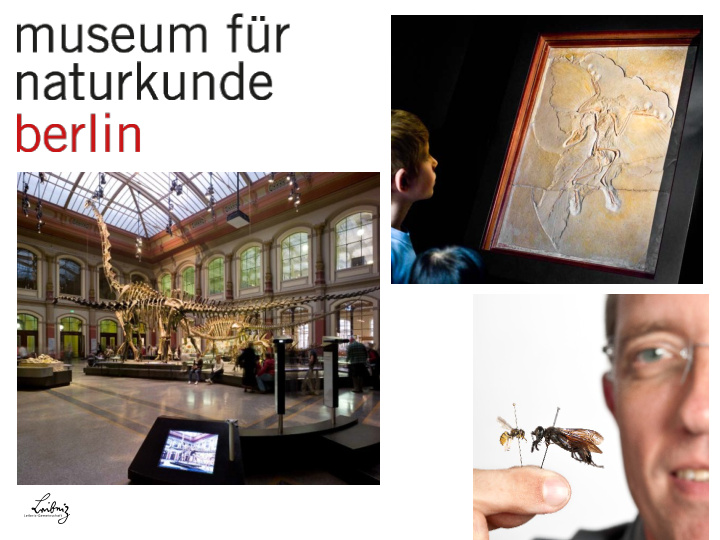



Digital representations of the collection objects in the Museum für Naturkunde Berlin Falko Glöckler, Jana Hoffmann, Gregor Hagedorn
Identifiers “An identifier is a unique identification code that is applied to 'something', so that the 'something' can be unambiguously referenced.“ K. Richards, R. White, N. Nicolson, R. Pyle, (2011)
Identifiers “An identifier is a unique identification code that is applied to 'something', so that the 'something' can be unambiguously referenced.“ • unique • stable / persistent • citable online & offline K. Richards, R. White, N. Nicolson, R. Pyle, (2011) • (somehow) resolvable
Strategy • Choice of IDs is strategic question Anyway, we want to present our data online! So we will use web-based systems / services!
Advantages of URIs • URI = Uniform Resource Identifier • globally unique through controlled web domain • dereferenced via standard web protocol HTTP – content (type) negotiation – standard software and services • easy to use for users and maintainers – intuitively ready for use (users) – dereferencing is easy to configure (admins) • cheap • semantic web / linked data • high probability of being sustainable over decades
CETAF ISTC • aims to implement a consistent identifier system i.e. collections held by CETAF institutions • based on http-URIs • create endpoints querying lists / catalogues of all URIs ISTC … Information Science and Technology Commission
Stable URIs A generally recommended URI pattern: http://subdomain.yourdomain.org/path/variable-id Example: http://coll.mfn-berlin.de/u/ZMB_XYZ_123456
Stable URIs http://subdomain.yourdomain.org/path/variable-id • subdomain , because your web-domain is used for other content, too • yourdomain.org should be owned and fully controlled by you • path as a kind of “name-space”, because it's easier to redirect and is extensible for identifying other groups of resources • variable-id is your internal identifier (inventory number, UUID, etc.) and has to be locally unique
Stable URIs • Keep the pattern simple from the start, but flexible • Clean URIs instead of long GET-parameters http://coll.mfn-berlin.de/identifier.php?namespace=unit& inventory_number=ZMB_XYZ_1213456&redirect=1&collectio n=insecta http://coll.mfn-berlin.de/u/ZMB_123456
Stable URIs • Keep the pattern simple from the start, but flexible • Clean URIs instead of long GET-parameters http://coll.mfn-berlin.de/identifier.php?namespace=unit& inventory_number=ZMB_XYZ_1213456&redirect=1&collectio n=insecta http://coll.mfn-berlin.de/u/ZMB_XYZ_123456
Further reading and examples • Sauermann & Cyganiak 2008, http://www.w3.org/TR/cooluris/ • Hyam et al., Stable citations for herbarium specimens on the internet: an illustration from a taxonomic revision of Duboscia (Malvaceae) Phytotaxa 73: 17–30 (2012) PDF •http://www.pro-ibiosphere.eu/news/4296_stable identifiers for s •http://wiki.pro-ibiosphere.eu/wiki/Best_practices_for_stable_URI
Stable URIs @MfN
Stable URIs @MfN • For digital resources and physical objects!
Stable URIs @MfN • For digital resources and physical objects! But HTTP status code 303 “See other“
Stable URIs @MfN • For digital resources and physical objects! redirect
Stable URIs @MfN • For digital resources and physical objects! redirect
Stable URIs @MfN • For digital resources and physical objects! http://coll.mfn-berlin.de/u/MFN_MIN_1977_0386 http://coll.mfn-berlin.de/u/MFN_MIN_1977_0386.html http://coll.mfn-berlin.de/img/MFN_MIN_1977_0386__Achat_a.jpg
Landing page (HTML) http://coll.mfn-berlin.de/u/MFN_MIN_1977_0386 MINERALOGY COLLECTION
Landing page (RDF) http://coll.mfn-berlin.de/u/MFN_MIN_1977_0386
Content (type) negotiation • content negotiation based on HTTP Accept Header sent along with the request Accept: text/html => Content-type: text/html; charset=UTF-8 Accept: application/rdf+xml => Content-type: application/rdf+xml
Content (type) negotiation
Content (type) negotiation VAPOUR a Linked Data validator http://validator.linkeddata.org/
Content (type) negotiation VAPOUR a Linked Data validator http://validator.linkeddata.org/
Biodiversity data in Linked Data cloud
Cross-institutional search ?? ? ? ? ?
Cross-domain search
Entering URIs in daily work?
Entering URIs in daily work?
Quick Response (QR) http://coll.mfn-berlin.de/u/ZMB_Phasm_D038
Quick Response (QR) • QR codes => binary information • Machine readable – easily to include in digitization workflows – save time / avoid typos etc.
Quick Response (QR) • Binary „interface“ between physical object and digital representation
Use cases for mass digitization
Use cases for mass digitization Level 1 Level 2 Species Containers Level 3 Specimen i.e. Type specimens
(1) Collection management • Collections change – Track changes in your database just by scanning QR codes – URI redirects to edit form in the intranet
(1) Collection management • Shopping carts for collection objects for batch workflows
Generic tool for forms • Using customized forms in the free mobile application ODK Collect (www.opendatakit.org) • Trying to enhance – data capture – connection between physical object and digital representation in workflows
Batch process ODK form Examples: data • changes in location templates • loans • cataloging • demands for digital data databases
(2) Digitization starts in the field Coordinates (automatically) Time Locality Collector …
(3) Image analyses
(3) Image analyses
(3) Image analyses Detection of multiple QR codes in digital assets of natural history collections Glöckler et al. (in prep.)
(3) Image analyses i.e. for validation, segmentatation etc.
Conclusions related to DINA DINA efforts are a chance to ... • … better combine workflows in managing both, collections and their digital representations • … better interconnect collections • … join efforts in developing web-based components • … jointly implement (new) standards in collections
Thanks for your attention!
Recommend
More recommend